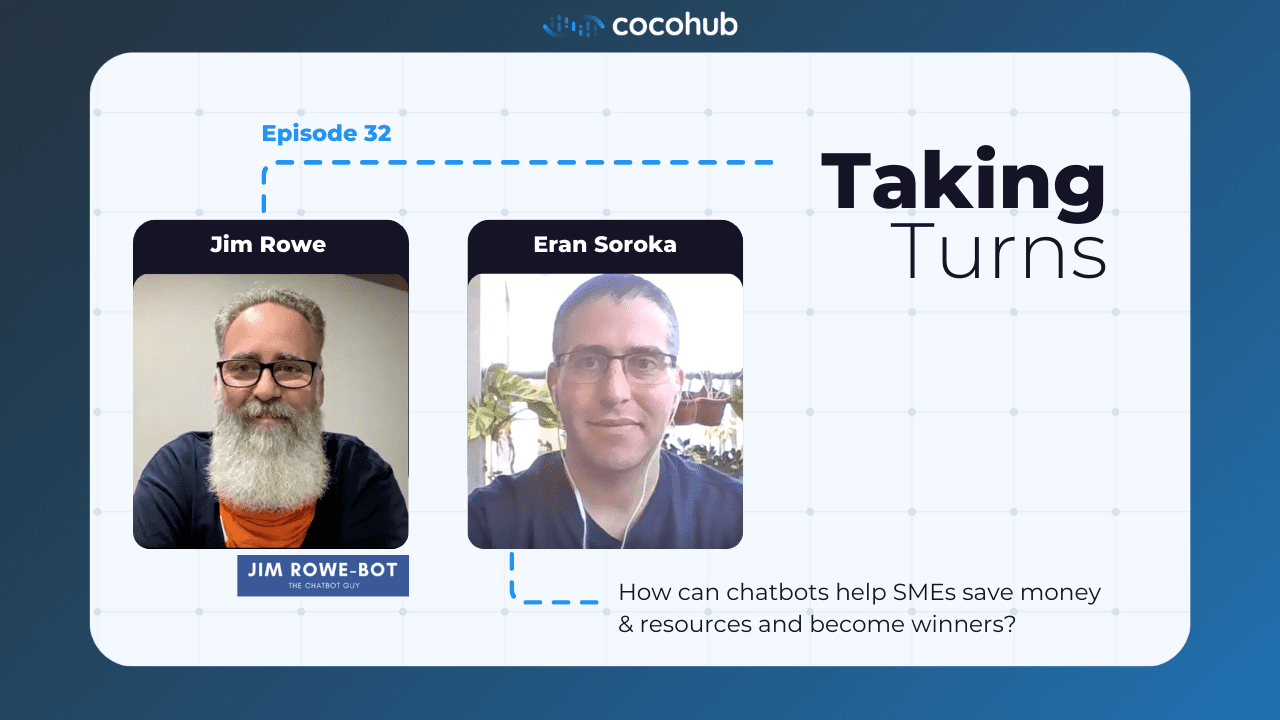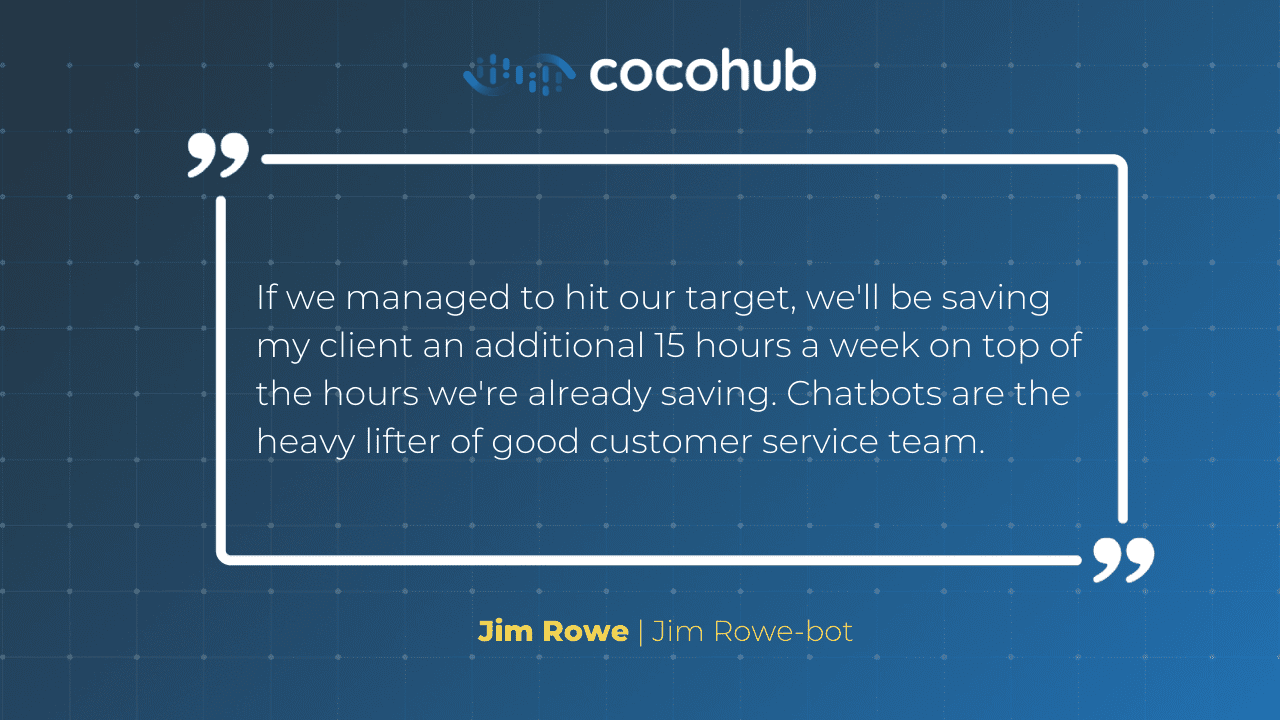Chatbots were already on the rise over the last few years, when the Covid-19 pandemic came and changed everything. SMEs were among the main victims; All over the world, they were forced to close their doors all over the world – and go online or go extinct. That was the point when chatbots for SMEs became a must-have. Businesses that came late to the party – or didn’t came at all – were left behind.
Brittish conversation designer Jim Rowe – a.k.a Jim Rowe-bot – is helping businesses thrive in the online world for more than a decade. In that regard, becoming a conversation designer was only a natural step for him. In the latest (and 32nd) episode of Taking Turns, he talks with us about his experience. What is the pain point that forces SMEs to ask for help? What are the “early wins” that can be your first viable target when writing a bot? Why franchises are the next big thing for bot creators? And why two words – “Thank You” – signal so much for him?
How did you become a conversation designer?
Well, like a lot of people today, it’s quite accidental. Now going forward, as it’s become more of a job role, we’ll see more people that choose to become conversational designers. However, I think most of us have fallen into that.
Originally, when I started exploring chatbots, it was the domain of computer scientists. Really, it was all around machine learning and AI, something I knew very little about. But over the years I’ve seen how that’s got democratized. While I was working in marketing, I saw opportunities to use chatbots to turn website visitors into paying customers. From there, I focused on conversational design. Really, I got hooked. Although I was never into copywriting, conversational design is the joy of being able to take a customer down a conversation and deliver a result for a business – and the data that the businesses get from that, which they often underrate.
You’ve been in this field for almost a decade and a half. What’s the most substantial breakthrough that made chatbots for SMEs such a necessity?
First of all, democratization helps. Now it’s much easier for people to learn the basics. Back when I started it was reading a lot of articles, watching a lot of videos, but it was very high-end ML, AI scientific stuff. Now there are so many resources out there, it’s so much easier. Basically, you can do a conversational design course now, which was never a thing.
Also, the low-code, no-code option opens the door for many people. Really, it’s no longer the domain of the techie to be the conversation designer. Nowadays, that person is a conversational copywriter effectively, a behavioral analyst. They get into the shoes of the customer. Furtherly, low-code/no-code means that anybody can start learning those skills today.
What’s the bot or the project that you’re most proud of?
I supposed I’m always fond of that first one I ever built. Looking at it now, it was embarrassingly basic. However, that’s where I first learned how to do it, and I really enjoyed that process. Actually, that’s what got me hooked on conversation design.
In addition, recently I did a project for a company that turns over 20 million a year. Their product is sold in 55 countries, and they’ve been seeing massive growth over the last two years. However, managing the amounts of conversations they were receiving – via chat, via email – was just overwhelming for them. So we built them a chatbot, an NLP chatbot that had over 130 FAQs.
When we initially launched, we launched just on messenger as our beta. So it was handling a couple of hundred messages a week. From that, we were able to train the NLP engine, and it was averaging 15-20% correct, which was a good start because they didn’t have too much conversational data. Today, it’s been as high as 49% of conversations handled by the chatbot alone, which is huge for them. So we were already talking about the next phase of the chatbot and how we can increase that conversion.
We think we can get somewhere up to 65-70% of all conversations handled by chatbot without any human assistance.
Ready to build your bot on cocohub? Start here!
How to invite a bot to a video meeting?
How to use and create intents in your bot?
You do not only create chatbots for SMEs, but you also help them with social media. Do you feel that the audience’s will is changing, maybe from being passive consumers to ones that want to talk with businesses and companies?
Definitely, behavior change is happening. However, I don’t think that is the main driver. I don’t think that they’re looking at brands – there may be particularly high-profile brands, that top 10%, that people want to engage with and have a chat with. But for day-to-day brands, I believe that customers are handing off responsibility to get answers. Basically, I think that’s where chatbots really assist.
People are busy. A young mom, she’s busy. She drops the kids off at school, she goes off to her work. Over a lunch break, she does some shopping. At the end of the day, she picks up the children & runs them to their clubs. In between, she has these very small windows to get things done that aren’t focused on the children. Stuff we all have to do every day – paying your gas bill, speaking to your phone company, whatever. So people just don’t have the patience to send an email anymore. Instead, they want to start a chat conversation, to get straight to the point, to get an answer. If they can’t get an answer, they want to hand over the responsibility of that issue to that business.
And I think that is the main driver – we’re all terribly busy. And why would you use chat all day with your friends and family, then choose another medium with businesses? It doesn’t make any sense. So I understand businesses find it quite difficult to make that transition over to chats, live chat, and chatbots working together is beautiful. However, they’ve got to make it because that’s what customers expect now. The customers are busy people. So they need help to make purchasing decisions, and they need customer support, and they’re going to choose chat.
So why are these SMBs so afraid or deterred, as you said, to go to chatbots? Are they afraid of handing off the responsibility to an automated thing or what’s behind it?
Oh, there are 1,000,001 reasons not to do something. Especially within bigger businesses, it’s not until the pain becomes too painful – losing customers, losing money, and getting complaints – that often people made the decision that they need to do it. So, the businesses that are winning are the ones that have kept an eye on the market. Since they really understand that their customer behavior changes, they’ve been looking at ways to be better.
Chatbots are not the be-all or end-all. If done well, they’re the heavy lifter of a good customer service team. Then they really support the customer service team, allow the customer service team to focus on the more difficult, more challenging issues that customers have. Also, where a chatbot is clever, is it dealing with those quick and simple questions. As I and my latest big client were working it out yesterday – if we managed to hit our target, we’ll be saving them an additional 15 hours a week, on top of the hours we’re already saving.
In short, customer service people are expensive to hire, expensive to train, and very expensive to keep. So if you want to keep them longer, make their job more interesting. Just let them deal with the complicated queries, not the simple, repetitive stuff that bores everybody.
Previously on Taking Turns | Watch the whole playlist
Aishwarya Kamath on how Wysa created a mental health chatbot
Brittany Neal on how Wix uses chatbots to reach millions of users
Christy Torres explains what does a finances chatbot needs to do
What is the most important thing these days when building chatbots for SMEs?
Mainly as a conversational designer, there’s no really good conversational data before you start the project. Often you’re second-guessing, making assumptions of what the customer needs, and you’ll never be 100% correct. So for me, the biggest challenge is looking for where you can get the early wins.
For instance, recently I was speaking to a horse racing course bot. There are lots of very similar questions – pre-race, race day, post-race. Also, they’re a venue, are conferencing suite so they do lots of other things. So to cover all of those different categories in one bot is really difficult.
So, focus on where can you have the biggest impact, and where can you get the chatbot live and collecting data. Of course, it would have pre-sale, pre-race-day conversations, and that’s where you focus, and where when you’re trying to sell. Because not only do I build them, I have to sell them to businesses. So when you’re trying to sell, look where you can have the biggest impact. Most quickly, show that the chatbot can support the business’ growth. Really, it can be an asset to a customer service team. Once you have that limited small impact, it really opens the eye for the customer.
So for sellers of conversational design or chatbot, or the whole packages I do, look for the quick wins. Don’t go in, in tens of thousands of pounds to do everything and oversell. Often you haven’t got the conversational data. Some businesses turn in over tens of millions and actually customer service is being handled by the marketing team. They don’t want to do that. They would much rather that the chatbot did the heavy lifting and they could deal with the detailed queries.
So that’s what you, Jim Rowe-bot, your company, is dealing with? That’s what you’re focusing on?
So we turn to a wide variety of businesses, and I’m lucky I can pick and choose my clients. My real forte is startups or businesses that experience a lot of growth.
Currently, I’m exploring a new market, which is franchises. For franchisors, the ones that own all of the assets, they have got an opportunity. Since they don’t see it yet, I need to educate them to collect conversational data from all their franchises. So if they are in control of the chatbot, they get all of that customer conversational data. Therefore, they can improve their service, they can better serve customers, and grow their franchise.
Obviously, there are franchise gyms. For example, “Anytime Fitness” with 4,500 around the world. Now, lots of them are starting to see the benefits of having a chatbot on their website. They’ll always have a Facebook business page, and they may even have Instagram now. However, if you had the franchisor, very top of the tree, providing the chatbot to the franchises… Because 80% of the questions are the same. What time are you open? What time do you close? How much does it cost? Can I pause my membership, how much is membership? Then 20% will be location-specific simple questions. What classes are going on? Where’s the car park?
Now, if the franchisor could control that – there is a mass. Imagine if you had a thousand sites all having 200 conversations a week. It’s a lot of conversational data that franchisees can use. So I’m a bit passionate about franchises. It’s a growing area. Franchises are always growing and I think they’ve been reluctant or unaware of the benefits that chatbots can bring. Here, conversational design can sell more of their product or service.
They’re probably thinking about more B2C instead of B2F, B to the franchisee.
Exactly – they could sell that product straight to the franchisees, but they’re getting all of the customer data, controlling it. So they control the tone and the pace of the conversation and the brand. Nowadays, a lot of these franchises are launching their own chatbot, but they’re very off-brand. How do they control that? But it’s really difficult for them.
Can you recall a funny, awkward, or amazing experience you had with one of your chatbots?
I always say that no chatbot survives first contact and it’s true. When we launch a chatbot, customers get very scared, even I get very scared. Because you never know what somebody is going to ask. In that regard, I do remember one of my first ever big projects where we watched live a conversation happening. Effectively, the woman said “I love you” at the end of the conversation to the chatbot because it delivered such a fantastic service. It blew everybody away and actually helps sell more of the products so you can’t complain.
Actually, I get real joy from just seeing customers have a great experience. I recently post on LinkedIn and ask whether customers saying thank you at the end of a conversation with a robot was a good measure of its success. Although it’s a soft measure, it’s really warming. I look at the data for some of my bigger clients, and the number of times people, although they know it’s a chatbot, will say thank you – yeah, that’s the heartwarming bit.
Since many, many years ago I worked in customer service, I know that happens with customer service teams. So for me, that is the big driver. If I can show clients that customers not only get the results they’re looking for – often not the results they want; For instance, if they’re asking for a refund and there’s no refund policy, that can be quite a tricky conversation to robotize. However, if I can show customers that their customers are not only getting through a conversation without any human input but then also thank him for that conversation? Yeah, that’s the real dream for me.
You talked about the franchise vertical going to be maybe one of the next big things. Do you have any other forecast for the future of Chatbots or conversational AI?
I don’t like to forecast too far into the future because I’ve watched the chatbot market for years. However, I keep a very keen eye on what’s happening around AI machine learning in chatbots. So I’ve got my Google Alerts set up, I read all the news, I see all the acquisitions and funding.
While looking at what’s happening, I feel that there are two ends of the market. You’ve got the low-end, very small businesses that are launching an Instagram or a Facebook chatbot. On the other end, big banks and big customer service teams are launching chatbots. Then there’s a bit of a void in the middle, and that void is starting to close now. That’s where the real market is, in the middle of those two.
“It takes time to educate business leaders”
So, there are people that really enjoy working with small businesses, startups, the mom-and-pop businesses. Then you got the big businesses that will actually have conversational design teams. In the middle, there’s where I operate, with the ones who won’t have their own conversational design teams or even the skills. However, they want someone that can hold a hand through a project and take them through.
In my heart, I’m a project manager, really who loves conversational design. So that middle bit now is starting to move, which I think is quite exciting.
I look at the big social media giants and how they’re focusing on chatbots. Although we knew Instagram was coming and it’s arrived, for most businesses it’s pretty pointless. Then if you’re e-commerce, if you think about the social media giants and then look at all of the big businesses that are getting only on this now. I saw one the other day, it was an amazing bit of software that was able to save conversational data from 3 or 6 months back. Then it can recall that back into a conversation, which could be really, really exciting.
So I won’t make too many predictions. I expect growth, but I don’t expect it to be meteoric growth. It takes time to change business, to educate business leaders and they really don’t know anything.












